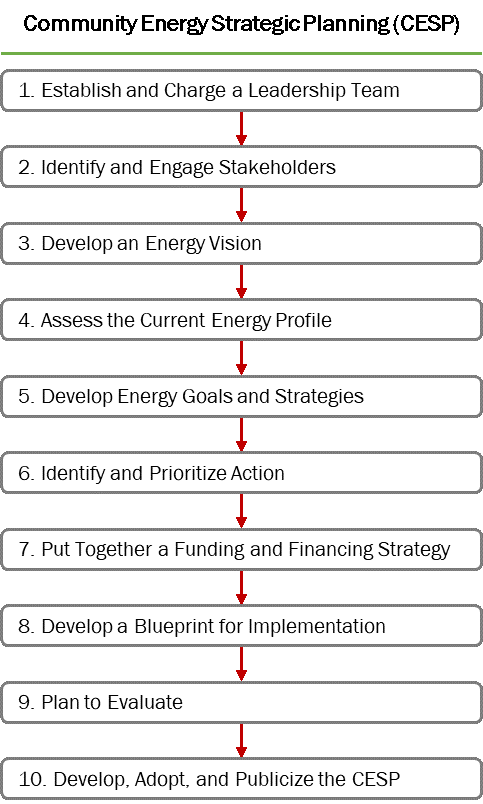Highlights
- The Department of Energy’s Guide to Community Energy Strategic Planning offers a comprehensive step-by-step guideline and tools for establishing energy management programs.
- Accessing and organizing energy data is a time-consuming but valuable first step in energy management. SECO resources help reduce the burden of organizing data and identifying savings.
- “SMART” (Specific, Measureable, Attainable, Relevant, and Time-Bound) goals can help ensure municipal energy management goals are designed for success.
- Training and certification programs like Building Operator Certification (BOC), Certified Energy Manager (CEM), and Accredited Texas Energy Manager (ATEM) prepare building operators to run building systems correctly and efficiently.
Guide to Community Energy Strategic Planning (CESP)
The ten step process is detailed in the full guidance document and the CESP website offers an array of tools and summary presentations for each step.

Other Best Practices in Energy Management
Access and Organize Energy Data
Accessing, organizing, and analyzing energy use data is an essential first step in developing an energy management program. Unfortunately, preparing energy data for the entire portfolio of municipal facilities can be a time consuming undertaking. Yet, investing the time could uncover no-cost savings opportunities by revealing ghost accounts (meters with no load) and other inaccuracies in billing. Data analysis is also necessary to identify opportunities and prioritize projects.
Cities are often managing an array of buildings and other unconventional energy accounts including streetlights. Simply organizing a comprehensive database of meter and account numbers can be challenging. Cities may be able to negotiate with their Retail Energy Providers to provide a list of accounts and associated meters. Other resources described below can also help facilitate data access, organization, and project identification.
SECO Data Access and Analysis Resources
The Texas State Energy Conservation Office offers local governments free resources to assist in the establishment of energy management programs. Preliminary energy assessments and remote energy audits help cities identify and prioritize energy savings opportunities. Technical resources can support energy data management, benchmarking building portfolio, and project development.
Data Access in Texas: Smart Meter Texas
Customers in competitive regions of Texas can access their interval meter data online through Smart Meter Texas. To date, participation in the online portal is extremely low because the process for customers to access data and authorize third party data access has been onerous by today’s standards for online transactions. However, a July 2018 settlement with the Public Utilities Commission of Texas is expected to alleviate barriers to sharing energy data with a third party energy management services starting January 2020.
ENERGY STAR Portfolio Manager
ENERGY STAR Portfolio Manager is a free energy and water benchmarking software developed by the US Environmental Protection Agency and Department of Energy. See the Benchmarking module of City Efficiency Toolkit for more detail on Portfolio Manager and other benchmarking and portfolio management tools.
Set SMART Goals
Adapted from Local Government Energy Management Goals: Best Practices and Platforms:
- Specific: Goals should be detailed, clear, and easy to understand with defined metrics and scope.
- Measurable: Progress toward achievement of goals should be measurable with available data and progress trackable over time.
- Attainable: Goals should strike a balance between meaningful, ambitious, and realistic. Build in intermediate steps to achieve longer term ambitious goals. Assessing if a goal is attainable means benchmarking current energy management to assess savings potential; surveying funding, resources, and political will; and learning from peer city achievements.
- Relevant: Don’t try to fit a square peg into a round hole. Goals should align or work in concert with city vision, existing plans, and departmental operations. Use short term goals to lay the foundation for longer term projects that require organizational or priority shifts.
- Time-Bound: Establish a clear baseline year for goals and a timeline with specific intermediate milestones.
For more detail on municipal energy management goal setting, see ACEEE’s Local Government Energy Management Goals: Best Practices and Platforms.
Case Study: Breakdown Silos
Operate and Maintain Building Correctly
A number of certification programs offer building operators, energy managers, and engineers training on how to properly evaluate energy efficiency opportunities and operate building systems to avoid waste.
Building Operator Certification Program
The Building Operator Certification (BOC®) program is a national training and certification program for building operators that offers combined classroom and online instruction that, merged with hands-on projects, translate into reduced building operational and energy expenses, extended longevity of building equipment, and a confident, competent workforce.
SPEER is the authorized provider of BOC for Texas and Oklahoma.
Certified Energy Manager (CEM)
The Association of Energy Engineers’ (AEE) Certified Energy Manager is a nationally recognized certification for optimizing energy performance of facilities. CEM applicants must document professional energy management or engineering experience, complete a CEM training seminar, and pass an open book examination.
Accredited Texas Energy Manager (ATEM) and Master Texas Energy Manager (MTEM)
The Texas Energy Managers Association (TEMA) offers the ATEM credential for demonstrated knowledge of basic energy management policies; procedures and best practices; energy systems; how to perform energy audits and economic analysis; energy accounting, financing, and project deliver; energy procurement; and an introduction to sustainability rating systems, codes and commissioning. A Master Texas Energy Manager (MTEM) has received training in creating a detailed Energy Master Plan tailored to the specific needs of their organization.